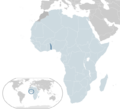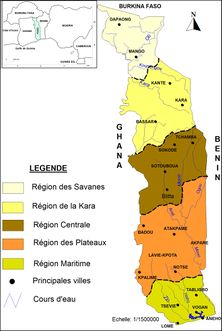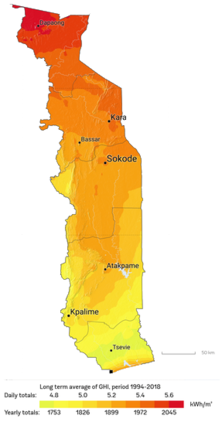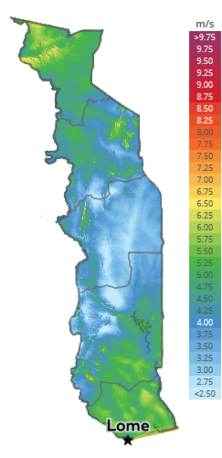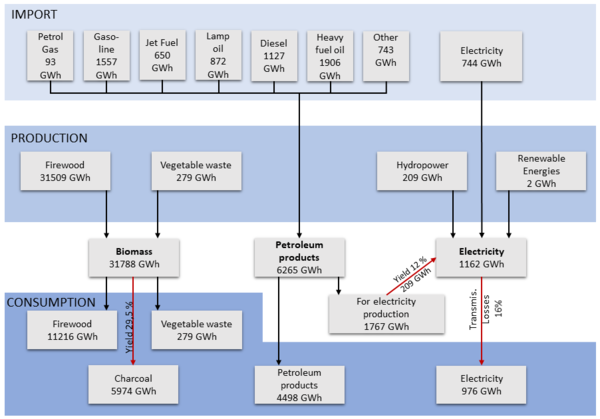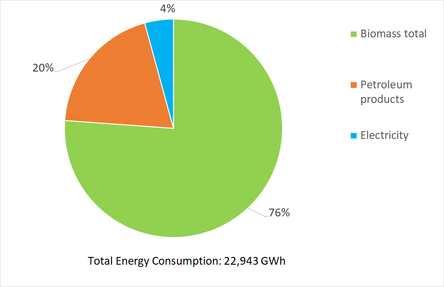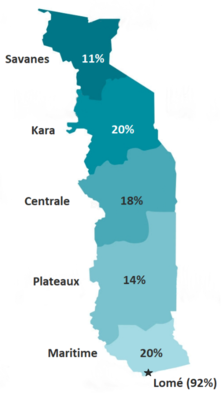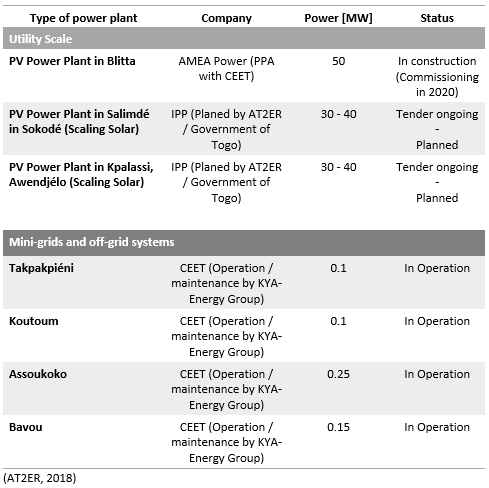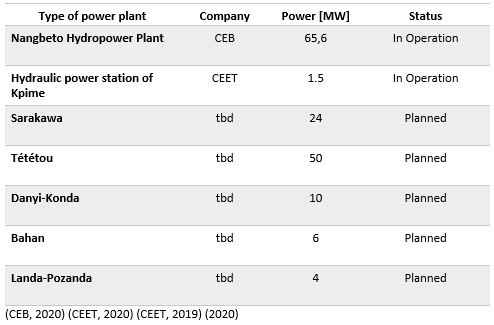Knowledge fuels change - Support energypedia!
For over 10 years, energypedia has been connecting energy experts around the world — helping them share knowledge, learn from each other, and accelerate the global energy transition.
Today, we ask for your support to keep this platform free and accessible to all.
Even a small contribution makes a big difference! If just 10–20% of our 60,000+ monthly visitors donated the equivalent of a cup of coffee — €5 — Energypedia would be fully funded for a whole year.
Is the knowledge you’ve gained through Energypedia this year worth €5 or more?
Your donation keeps the platform running, helps us create new knowledge products, and contributes directly to achieving SDG 7.
Thank you for your support, your donation, big or small, truly matters!
Togo Energy Situation
Capital:
Lomé
Region:
Coordinates:
6.7° N, 1.13° E
Total Area (km²): It includes a country's total area, including areas under inland bodies of water and some coastal waterways.
XML error: Mismatched tag at line 6.
Population: It is based on the de facto definition of population, which counts all residents regardless of legal status or citizenship--except for refugees not permanently settled in the country of asylum, who are generally considered part of the population of their country of origin.
XML error: Mismatched tag at line 6. ()
Rural Population (% of total population): It refers to people living in rural areas as defined by national statistical offices. It is calculated as the difference between total population and urban population.
XML error: Mismatched tag at line 6. ()
GDP (current US$): It is the sum of gross value added by all resident producers in the economy plus any product taxes and minus any subsidies not included in the value of the products. It is calculated without making deductions for depreciation of fabricated assets or for depletion and degradation of natural resources.
XML error: Mismatched tag at line 6.2 ()
GDP Per Capita (current US$): It is gross domestic product divided by midyear population
XML error: Mismatched tag at line 6. ()
Access to Electricity (% of population): It is the percentage of population with access to electricity.
XML error: Mismatched tag at line 6.no data
Energy Imports Net (% of energy use): It is estimated as energy use less production, both measured in oil equivalents. A negative value indicates that the country is a net exporter. Energy use refers to use of primary energy before transformation to other end-use fuels, which is equal to indigenous production plus imports and stock changes, minus exports and fuels supplied to ships and aircraft engaged in international transport.
XML error: Mismatched tag at line 6.no data
Fossil Fuel Energy Consumption (% of total): It comprises coal, oil, petroleum, and natural gas products.
XML error: Mismatched tag at line 6.no data
Introduction
Geographie
Togo is a state in West Africa, located on the Gulf of Guinea. It borders Burkina Faso to the north, Benin to the east, Ghana to the west and the Atlantic Ocean to the south. The country covers almost 57.000 km². The plains in the north and south are dominated by savannah land, which makes up about 23% of the country's total area. About 16 % of the country is covered by tropical rainforests and savannah forests, about 33 % is used as meadow or grassland and about a quarter is used as agricultural land, especially for coffee, tea, cocoa, cotton, coconut and peanuts, cassava, rice, millet and corn. The country is divided into the regions Maritime, Plateaux, Central, Kara, Savanes. (Togo, 2020)
The longest river is the Mono with 467 km length. It runs from north to south and can be used as a waterway for 50 km. The river is also used for energy production with a large hydroelectric power plant, at the Nangbeto Dam. The reservoir near Atakampé dams the river Mono. The lake is used for irrigation for agriculture and for electricity production. (Worldbank, 2017)
Climate
The climate is tropical humid all year round, with average temperatures of 30°C in the north and 27°C on the coast in the south. There is only a slight cooling at night. Due to the elongated shape of the country, there are different climatic conditions in the north and south of the country. The North is strongly influenced by the continental climate. The rainy season takes place there from May to October. August is the coolest month, January the driest. Located on the coast, the south, is strongly influenced by the maritime climate. There are two rainy seasons from April to June and from September to November. The driest month is December, the coolest month is August. (DWD, 2020)
The high and over the year relatively constant solar radiation results in a high value of available solar energy. By means of satellite data of the solar energy per day and per year it can be estimated which region is particularly suitable to produce solar energy. The solar irradiation increases from south to north. In the dry regions in the very north of the country, the solar irradiation reaches its maximum with a value of 2045 kWh/m² per year. (Global Solar, 2019)
According to the data of the Global Wind Atlas, Togo is located in an area with very low winds. On the coast in the south, wind speeds are on average higher than in the interior. Furthermore, there are greater amounts of wind speeds in higher and mountainous areas. (Global Wind, 2019)
People and Society
Togo is one of the most densely populated countries in Africa, with most of the population living in rural communities, with the highest density in the south near the Atlantic coast. The distribution of the population is very uneven due to variations in soil and terrain. The population is generally concentrated in the south and along the major north-south motorway that connects the coast with the Sahel. The age distribution is also uneven; almost half of the Togolese are less than fifteen years old.
French, the official language, is used in administration and documentation. The public primary schools combine French with "Ewe" or "Kabye" as the language of instruction, depending on the region. English is spoken in neighboring Ghana and taught in Togolese secondary schools. Therefore, many Togolese, especially in the south and along the border to Ghana, speak some English. (CIA World, 2015)
The population of Togo is estimated by the UN at 8 million in 2018. The five largest cities in the country are: Lomé (capital), Sokode, Kara, Atakpame and Kpalime. In total, these cities have a population of 3.3 million and 4.7 million in the countryside. This means that 41.7% of the total population lives in urban areas. There are many different ethnic groups in Togo. It is estimated that there are up to 37 different groups. Among the largest are the Adja-Ewe/Mina with 42.4% and the Kabye/Tem with 25.9%. (2013 - 14 est.) (UN, 2019)
The population of Togo is estimated to have grown four times its size between 1960 and 2010. With almost 60% of the population under the age of 25 and a high annual growth rate, largely due to high fertility, Togo's population is expected to continue to grow in the foreseeable future. In 2008, Togo abolished fees for primary school enrolment, which led to a higher enrolment rate, but increased the pressure on limited classroom space, teachers and materials. Togo is well on the way to establishing universal primary education. However, the quality of education, the low percentage of girls and the low enrolment rate in secondary and higher education remain challenges. (CIA World, 2015)
Energy Situation
Energy Consumption
Togo's energy consumption comes from three sources: biomass, petroleum products and electricity.
Biomass consumption comes entirely from domestic resources. The total production amounts to 31.788 GWh of primary energy, with the largest part coming from firewood and the rest from plant waste. The firewood is mainly used by households (35%), which corresponds to an energy of 11.216 GWh. Almost all the rest is converted into charcoal. The conversion takes place with an energy efficiency of 29.5%, resulting in a final consumption of 5.974 GWh. A small amount of vegetable waste with an energy of 279 GWh is also used unchanged as an energy form.
The oil products are completely imported. The largest part (72%) is consumed directly. The largest consumer here is the transport sector. The rest is used for electricity generation with an efficiency of 12% for public power stations.
The available electrical energy in Togo in 2016 is 1.162 GWh of wich 744 GWh is imported. The remaining energy comes from domestic production. The two largest energy suppliers here are hydropower with 49% and fossil fuels with 50.6%. A small part 0.4% is obtained by burning biomass or other renewable energy. The values used in the statistics refer to production from the hydraulic and thermal plants of the Communauté Electrique du Bénin (CEB) in Togo, the Compagnie Energie Electrique du Togo (CEET) and an independently managed power plant of Contour Global. The statistics are supplemented by imports from the Volta River Authority (VRA) in Ghana and the Compagnie Ivoirienne d'Electricité (CIE) in Côte d'Ivoire. In total, electricity supply of 1.162 GWh is thus achieved through distribution losses, resulting in a final electricity consumption of 876 GWh.
The total energy consumption of 22.943 GWh is divided into 4% electrical energy, 20% petroleum products and 76% biomass. A large part of this energy is consumed in households (73.5%), followed by the transport sector (13.2%) and the market sector (10.1%). Industry consumes a share of 3%. Households use mainly wood as a direct form of energy (56.9%) but also charcoal (33.7%). Electricity is used as a form of energy in 3.6% of households. In the transport sector, a lot of petrol (46%) and diesel (35%) is used. In industry, there is an even distribution in the consumption of electricity (36%), diesel (37%) and fuel oil (27%). (SIE, 2017)
Electrification of Togo
The rate of access to electricity in Togo is increasing (from 17% in 2000 to 45% in 2018), but with large differences between urban (access rate = 88.8%) and rural areas (access rate = 8%).
Most of the electricity produced domestically is based on hydropower and fossil fuels. The amount of electricity produced fluctuates greatly from year to year. In 2017, hydropower had a 69.1% share and the share of electricity produced by petroleum products was 24.7%.
Renewable energy sources (solar, wind, etc.) are already present in the country's electricity generation capacity and have been experiencing great growth for several years. The latest figures (2017) assume a share of 6.2%.
Most of the demand is imported from the countries of the sub-region (Ghana, Nigeria, Cote d'Ivoire...) through an interconnection network. However, the continuity of the electricity supply service is not guaranteed and constitutes a challenge for the national company CEET in charge of distribution
In recent years, progress has been made in the electrification of the country's major cities. However, great efforts are also being made for rural electrification, but it still represents a major challenge. A total of 4 million inhabitants in Togo still must be supplied with electricity.
Currently, an electrical power of 230,000 kW is produced in the country. It is estimated that in 2030 a total of 100,800,000kW of electricity will have to be produced to supply the entire population with electricity. (PERC, 2015) (Global Lightning, 2018)
The National Electrification Strategy was developed to realize this (see chapter 6). With this project, the government of Togo has set itself the goal of expanding renewable energy in particular and implementing various new strategies to provide universal access to electricity. The focus is on the expansion of solar energy for the electrification of rural areas. In addition, new opportunities for hydropower are to be developed. This technology has so far only been used in large-scale projects. In the future, however, smaller plants are also to be implemented. (CIA, 2016) (Worldbank, 2017) (SET, 2018)
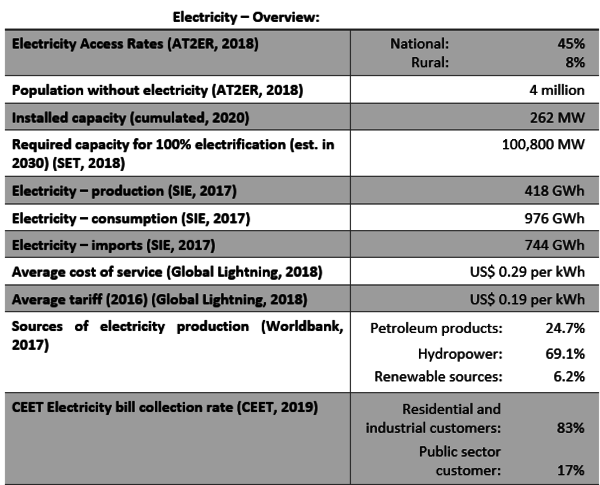
Renewable Energy
Solar Energy
Currently, many projects are being implemented that use solar energy. PV systems can be used flexibly at utility or small scale to generate electricity. Utility scale solar power plants can thus directly feed the public power grid with electricity. Mini-Grid and Off-grid-systems are smaller solar fields providing electricity directly to remote villages and rural communities that do not yet have access to the grid. But also, single private households can be supplied with electricity by solar-home-systems (SHS) and solar kits.
Utility scale: The first large photovoltaic solar power plant with a total capacity of 50 MW will be built in the town of Blitta by the end of October 2020. The project will be implemented in two phases: the first phase of 30 MW, which will be commissioned at the end of June 2020, and the second phase of 20 MW, which will follow at the end of October 2020. The plant is to improve the quality of the national electricity supply. (AT2ER, 2018)
An announcement for another major project was made in December 2019. Scaling Solar which was initiated in Togo by the Togolese government in cooperation with the Togolese Agency for Rural Electrification and Renewable Energy (Agence Togolaise d'Electrification Rurale et des Energies Renouvelables - AT2ER) and IFC, launched a tender to build and operate two grid-connected PV solar plants based on an IPP. The total cumulative capacity is expected to be around 60 to 80 MWp. The two systems will be installed in Kpalassi in Awandjélo in the Kara region and in Salimdè in Sokodé in the central region of Togo.
Mini-Grid and Off-Grid systems: In addition to the planned large solar power plants, several Mini-Grid and Off-Grid systems already exist. In order to ensure the optimal operation and sustainability of these solar mini power plants, the Ministry of Energy and Mines is hiring KYA-Energy Group to assist the Directorate General of Energy (DGE) in monitoring, managing and operating these mini power plants. (Prof.AZOUMAH, 2019)
Solar Home Systems (SHS) / Solar Kits: Another way to supply private households with electricity is to use solar kits . Solar kits are PV systems for individual use and can be used to supply electricity to individual electrical devices or entire households. There are already several companies and projects active in this field to spread the use of solar kits throughout the country (see chapter 6). (Global Lightning, 2018)
Hydropower
Hydropower is one of the main sources of base load electricity generation. Togo's hydropower potential is highly seasonal, with seasons varying from region to region. The main current use of hydropower potential is focused on the Mono River. However, operating data from the Nangbeto power plant have shown that the Mono River has a triple degree of variability: event-driven, seasonal and multi-year. This makes this source an "opportunity resource" which must have an "equivalent resource in reserve" in the CEET and CEB supply park, otherwise technical failures cannot be avoided in the event of a sudden drought and very high replacement costs may be incurred in the event of a prolonged drought. Therefore, any additional development must consider these event-driven (torrentiality), seasonal and multi-annual intermittent operations. In order to continue exploiting the capacities of the Mono River, a rehabilitation of the Nangbeto dam is planned. Another project on the Mono River is located in Adjarala. The Adjarala site has been the subject of several studies, the results of which are still open to question. On the other hand, small rivers and streams could be exploited for small (less than 10MW) hydroelectric projects. There is certainly an urgent need to develop small hydropower plants for the supply of electricity to rural areas and remote communities. (PERC, 2015)
In Togo, the government is planning to develop an energy program under the PND in addition to the Kpimé dam, "which should help to exploit the hydropower potential through the construction of dams (Tététou (50 MW), Danyi-Konda (10 MW), Baghan (6 MW), Landa-Pozanda (4 MW)). (Togofirst, 2018)
Another project to be implemented shortly is the construction of a 24 MW hydropower plant in Sarakawa. The project is being developed on behalf of the Togolese Agency for Rural Electrification and Renewable Energy, Agence Togolaise d'Electrification Rurale et des Energies Renouvelables (AT2ER) and with support of the French Development Bank, Agence Francaise de Développement (AFD). The power plant is expected to provide electrification for up to 29 communities in the region. The project aims to reduce electricity supply shortages at a time of rapidly growing demand, to reduce Togo's dependence on electricity imports from neighboring countries and to expand access to electricity throughout the West African country. The implementation of this project falls within the framework of the electrification strategy. (AT2ER, 2019) (Hydropower-Dams)
Table 3 Overview of all planned and already operated hydropower plants in Togo. The largest hydropower plant, the Nangbeto Hydropower Plant, has been in operation for several years and makes a major contribution to the electricity supply in Togo. Many smaller power plants are already planned.
Energy from Biomass
Direct use of Biomass: Vegetal biomass consists of forest resources and plants wastes. In Togo, household energy consumption is characterized by a very strong predominance of the Biomass. According to the 2017 report of the Togo Energy Information System (SIE), the share of biomass-energy reaches 76% of the national final consumption against 20% for petroleum products and 4% for electricity. Togolese citizens, whether rural or urban, mainly use the only energy resource available nationally, renewable and economically accessible: wood.
Based on the results of the in-depth study on the dynamics of wood-energy use in Togo by UCN REDD+, the volume of wood-energy consumed by households and socio-professional groups is estimated at 7,500,000 m³/year. In rural areas, the energy needs of the majority of the households are still met by charcoal and firewood. This predominance is also observed in previous studies (DGE 2007: 87%, QUIBB 2016: 86.9%).
Cooking technologies are diversified according to the place of residence (rural or urban) and have a significant impact on the quantity of fuel consumed by households. The use of improved cook stoves would save 30% about 1.5 million tons of wood per year. Several types of traditional and improved cook stoves are used in Togo. The most common are among others, the ASUTO stove, improved conical UB stove, the NANSU stove, the Improved three stone stove made with clay. These improved stoves are used more in urban than rural areas,
for the simple reason that the use of charcoal is higher in large cities. In Togo, nearly 82% of rural households have only a traditional 'Three Stones' stove for cooking with wood. The share of the population using improved stoves was 6.55% in 2010, it is estimated at 27% in 2020 (PANER 2015). These rates remain quite low for the achievement of the sustainable forest management objectives at national level, so it is necessary to take real account in designing new projects in the energy and environmental sector. It is in this context that in developing the National Action Plan for Renewable Energies (PANER) in 2015, Togo has set some key objectives for the 2020-2030 period, which include, among others, significant growth of the rate of use of improved stoves for cooking estimated to 27% in 2020 and 80% in 2030, to increase the charcoal production efficiency from 15% to 25% through the use of improved Kilns and to increase the rate of LPG use in domestic energy to 25% in 2020 and 75% in 2030.
Conversion of biomass into electrical energy : As described, the majority of the biomass is not used for electricity generation. Firewood and charcoal are mainly used as direct forms of energy in households (90,6% Firewood and charcoal). However, biomass can also be used to generate electrical energy in biogas plants. Other renewable raw materials besides wood can also be used for this purpose. Apart from wood, Togo has a wealth of unused biomass (land and water weeds), to which household waste, animal excrement (cow dung, pig manure, excrement of small ruminants and poultry) and other vegetable waste can be added. All these organic materials, to which biodegradable waste from food factories can be added, represent an important raw material for the production of biogas for domestic or public use (electricity production). Waste recycling is progressing well in Togo under the leadership of the Laboratory for Waste Management, Treatment and Recovery of the University of Lomé. At present, the electrical energy produced from biogas plants is classified as renewable energy, which accounts for a total of 0.4% of electrical energy production in Togo. (PERC, 2015)
Wind Energy
Compared to solar energy, wind energy is making a tentative start in Togo. So far it has only been used to pump groundwater. Initial explorations had shown that the Togolese wind resource is not competitive compared to other sources on utility-scale. (PERC, 2015)
Fossil Fuels
Key Problems of the Energy Sector
In accordance to Power Africa, these following challenges are the biggest for Togo's energy sector[1]:
- Limited experience with independent power producers (IPPs)
- High technical and commercial losses as a result of non-payments and aging infrastructure
- Lack of an integrated electrification strategy that aligns on- and off-grid access goals
Policy Framework, Laws and Regulations
Institutional Set up in the Energy Sector
Other Key Actors / Activities of Donors, Implementing Agencies, Civil Society Organisations
Further Information
- Togo subsidies off-grid solar to extend electricity access to all
- USAID Power Africa: Togo Factsheet
References
- ↑ Power Africa. (2018). Togo Factsheet. Retrieved from: https://www.usaid.gov/sites/default/files/documents/1860/Togo_-_November_2018_Country_Fact_Sheet.pdf


